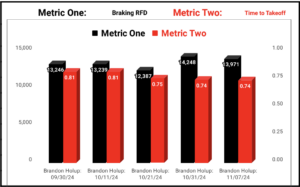
Scrutinizing Squatober
Today’s guest post comes from Cressey Sports Performance – FL strength and conditioning coach and sports science coordinator, Yassir Kahook.

Sorinex’s Squatober is a popular initiative that encourages consistent strength training for a month. It’s a great example of how consistent effort can produce measurable changes in strength and performance. Several of my coworkers participated in Squatober this year, giving me the opportunity to examine how such a routine impacts ground force production profiles and joint-by-joint ranges of motion. If you’re unfamiliar with Squatober, you can learn more at https://www.squatober.com/.
On September 30, I conducted baseline assessments for two coworkers, Austin Henrich and Brandon Holup. These assessments included a full-body range of motion screening and force production testing using Hawkins Dynamics force plates. Both individuals committed to the entire Squatober program, completing every session, and each increased their one-rep max back squat by about 25 pounds. Additionally, they performed regular jumps on the force plates throughout the month, allowing us to track changes in force plate metrics. The results were fascinating.
To ensure accurate post-training measurements, we waited a few days after Squatober ended before conducting follow-up evaluations. This waiting period allowed for supercompensation of strength gains and adequate recovery. Here are the results of their month-long journey.
Force Plate Metrics
I analyzed the force plate data from two perspectives: force-based metrics and velocity-based metrics. Interestingly, each coworker adapted differently in these areas. The force metrics I focused on were Braking Net Impulse and Jump Momentum, while the velocity-based metrics included Braking Rate of Force Development (Braking RFD) and Time-to-Takeoff.
From a force perspective:
Brandon experienced a slight decrease in Braking Net Impulse, dropping from 212 N·s to 188 N·s over the month. However, his Jump Momentum steadily increased from 348 kg·m/s to 359 kg·m/s.

Austin, on the other hand, showed an increase in Braking Net Impulse from 148 N·s to 158 N·s and an improvement in Jump Momentum from 282 kg·m/s to 295 kg·m/s.

It’s important to note that jump momentum is highly dependent on body weight as this is a part of the calculation. Brandon’s body weight stayed stagnant throughout the month while Austin gained 2 lbs over the course of the month. No large change in either of their mass’ shows the change in jump momentum came from an improvement in the ability to move their center of mass.
For velocity-based metrics:
Both Brandon and Austin improved their Braking Rate of Force Development throughout the month.
Brandon also saw a decrease in Time-to-Takeoff, indicating he could produce more force in a shorter time—an advantageous adaptation. In contrast, Austin’s Time-to-Takeoff remained stable.


Overall, both athletes became stronger and developed the ability to generate more ground force—a predictable outcome of a dedicated strength training program. The graphs below illustrate the monthly trends in these force plate metrics. Keep reading to explore the implications of these changes for athletes.
Force Plate Graph Shape (Signature)
Graph shape evolution provides additional insight, though this topic will be explored in more detail in future content. Briefly:
Brandon’s pre-Squatober graphs displayed a plateau with an early force peak (force peaking near peak braking). By the end of the month, his graphs shifted to an early peak bimodal pattern.


Austin’s pre-Squatober graphs exhibited a late peak bimodal shape, which transitioned to an early peak bimodal shape by the month’s end.


These adaptations could be considered advantageous for performance, depending on the athlete’s specific needs. Pre- and post-Squatober graph comparisons for both participants can be found below. Stay tuned for more content on how these changes might affect athletic performance.
Range of Motion Adaptations
From a broad perspective, both participants experienced predictable changes in mobility:
- Both gained shoulder internal rotation but lost some shoulder external rotation. This pattern is consistent with posterior rib cage compression and anterior rib cage expansion, which can result from extensive back squatting.
- Both lost hip and shoulder flexion, indicative of a global reduction in external rotation capacity.
- Additionally, they experienced slight decreases in thoracic rotation.
For the baseball strength and conditioning coaches out there, losing shoulder external rotation and flexion and thoracic rotation isn’t ideal if you want to keep your players healthy in a rotational sport that involved overhand throwing – so you either need to adjust your training approach or make an even more dedicated commitment to preserving mobility (both guys did thorough mobility warm-ups for this program).

The graph above summarizes average range-of-motion changes for each joint tested, with green (positive values) indicating increases, red (negative values) indicating decreases, and yellow (zero) indicating no change. Keep in mind that these are chronic changes; the measurements were taken cold after a “washout” period. The acute changes (i.e., right after squatting) may have been more significant.
Key Takeaways
While individual strength, speed, and mobility adaptations are important, the biggest takeaway from this case study is the variability in responses to the same training stimulus. Despite following identical programs, Brandon and Austin adapted slightly differently.
This case study highlights the importance of individualized programming for athletes. While group training may save time and improve efficiency, relying solely on one-size-fits-all approaches can lead to diverse adaptations within the group.
About the Author
Yassir Kahook serves as a Strength and Conditioning Coach and Sports Science Coordinator at CSP-FL. He completed an internship at CSP-FL in the Summer of 2023, and returned as a seasonal coach in the winter of 2023-24. Yassir played Division 1 collegiate baseball as a pitcher at the University of Akron, where he earned a BS in Exercise Science. He also played one year at the University of Toledo. He has previous experience working at Activ Physical Therapy in Ridgefield, Ohio, and also volunteered as a student-assistant in the athletic training room during his college experience. A CSP athlete during his college career, Yassir recognized the carryover his training had to on-field health and performance, so he’s excited to share his knowledge and experience with the next generation of CSP athletes.


